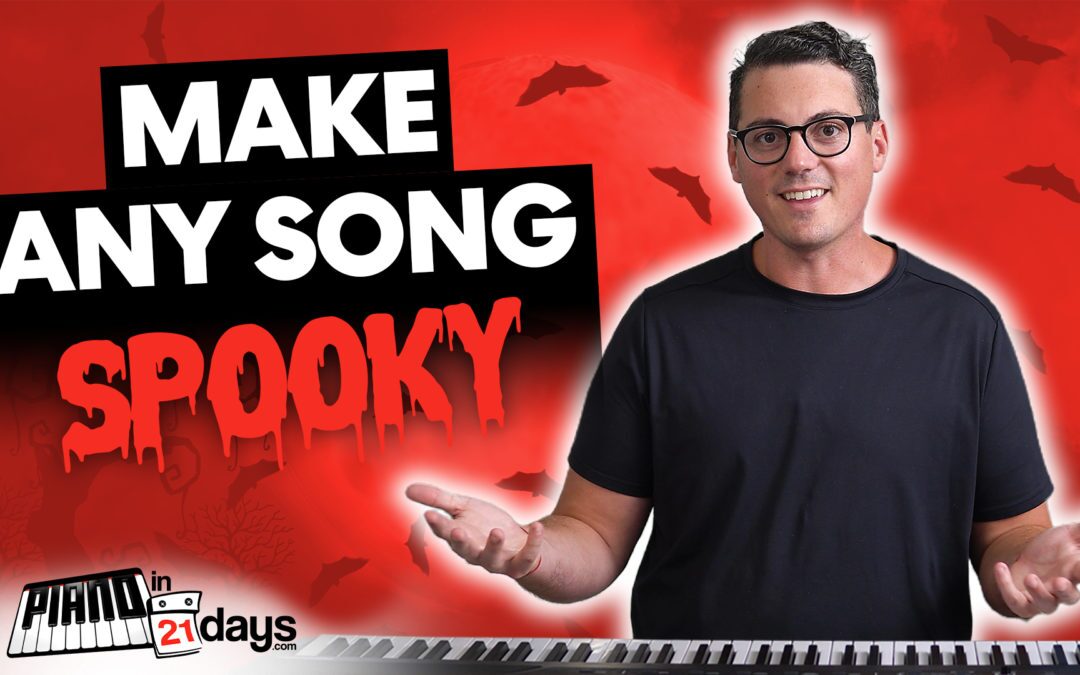Are you a fan of scary movies? Of Halloween? Of spooky things in general? Well then, it’s time for you to incorporate that into your piano playing!
From Cheerful to Spooky or Sad
How can you take something that’s normally very cheerful and upbeat (like a basic major chord), and change the mood entirely? If you’re a Piano In 21 Days student, you might be raising your hand excitedly:
“Ooh, I know! Play a minor chord instead!”
And that would be the start of a good suggestion! Minor chords are inherently more emotional and dark-sounding than major chords. So they’re definitely a good option for getting that moody sound. But just switching a major chord for a minor doesn’t really change the whole song. And if you substitute chords willy-nilly, you may accidentally end up with something that doesn’t work, musically-speaking.
But let’s kick things up a notch. Let’s learn how to convert a normal, upbeat-sounding song into something that still sounds like a song… but one with a completely different, spooky or somber feeling.
Relative Major and Minors
To convert a whole song, first you need to pick the song and pull up its chord notation (easily found with a quick online search). Got that? Now take a look and carefully note where all the major chords are.
Next, do NOT make the mistake of just changing them to minor chords! No, you can’t just make every C into Cm, every D into Dm, and so on. Trust me when I say that will sound scary, but not in a good way. 😉
We need to find the relative minors for each major, which means moving three notes to the left and play a minor chord, every time we play what would have been a major chord.
C major? That will become A minor.
F major? That’s now D minor.
G major? Change it to E minor.
And so it goes, for any major chord that you want to change to relative minor. Simply move it to the left by three spaces using a minor formula instead of the major formula. (There is some interesting music theory behind how all this works, but let’s keep this basic for now.)
In the video above, I show two examples of how this works and sounds. And I used some pretty cheerful, happy songs to illustrate just how different they are when converted to relative minors! That’s right, I took “Twist and Shout” and “Sweet Caroline” and played them this way. Hopefully The Beatles and Neil Diamond would appreciate the concept, even if it wasn’t quite what they were going for. 😉
The Spookiest Chord
Let’s look at a different aspect of creepy music. If you’ve ever shuddered at the eerie melodies of a Hitchcock movie, then you know firsthand the power of classic suspense soundtracks.
Sometimes, you don’t need a full song to turn things spooky. Have you ever watched Psycho? There’s a very specific chord in Psycho that immediately can turn a moment from calm to creepy. It’s known as the “spookiest chord in the world.”
How to Play the Hitchcock Chord
These things are a bit subjective, but there’s one particular chord that many people thinks wins the prize for being creepy! It’s called a major minor 7th chord, aka the Hitchcock chord.
Here’s how you play it (using C for our example):
-
- Place your right thumb on the root note (in this example, C)
- Place the next finger three notes to the right.
- Place the next finger four notes to the right.
- Place an additional finger four more notes to the right.
Steps 1-3 should feel familiar for anyone who’s spent time with my resources. But adding that additional finger really amps up the dissonance that makes this chord so uncomfortable-sounding.
You can experiment with playing different bass notes in the left hand (I played the two outermost notes with that hand). You can also try different improv techniques to vary this chord like you would any other. Arpeggios are a natural fit for creepy music, so make sure you try them!
Wrapping Up
Well, that wraps up our discussion of music with all the creepy, spooky, and somber vibes! These tips may not be broadly practical, but it’s always fun to try something new. Especially when it’s the spookiest time of the year!
For more “normal” chords and tips that work on just about every genre of music, check out my free 5-day workbook here.

